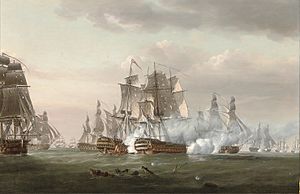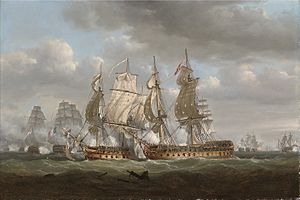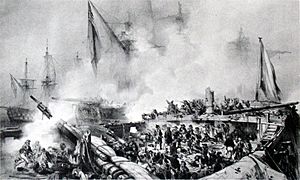HMS Tonnant facts for kids

Tonnant at the Battle of the Nile, by Louis Lebreton.
|
|
Quick facts for kids History |
|
|---|---|
| Name | Tonnant |
| Laid down | November 1787 |
| Launched | 12 October 1789 |
| Completed | September 1790 |
| Honours and awards |
|
| Captured | By the Royal Navy on 2 August 1798 |
| Name | HMS Tonnant |
| Acquired | Captured on 2 August 1798 |
| Honours and awards |
|
| Fate | Broken up in March 1821 |
| General characteristics | |
| Class and type | 80-gun Tonnant-class ship of the line |
| Tons burthen | 2,2813⁄94 (bm) |
| Length |
|
| Beam | 51 ft 9+1⁄4 in (15.8 m) |
| Depth of hold | 23 ft 3 in (7.1 m) |
| Sail plan | Full-rigged ship |
| Complement | 700 |
| Armament |
|
The HMS Tonnant was a powerful warship with 80 guns. Her name means "Thundering." She first belonged to the French Navy. Later, the Royal Navy of Britain captured her.
The British first took Tonnant in 1793 during the Siege of Toulon. But the French quickly got her back. Then, in 1798, Horatio Nelson captured her again at the Battle of the Nile. She then officially joined the British fleet as HMS Tonnant.
This famous ship fought in many important battles. These included the Battle of Trafalgar in 1805 during the Napoleonic Wars. Later, she became the main ship for Vice-Admiral Alexander Cochrane in the War of 1812. This was a conflict between Britain and the United States.
In 1814, Francis Scott Key visited Tonnant. He was trying to free a prisoner. After seeing the British attack on Fort McHenry in Baltimore, he wrote the words to "The Star-Spangled Banner." This later became the American national anthem. Tonnant was eventually taken apart in 1821.
Contents
Tonnant's French Service
Tonnant was the first ship in a group of 80-gun warships. These ships were designed by Jacques-Noël Sané. Her construction began in November 1787 at the Toulon Dockyard. She was launched on October 24, 1789.
In August 1793, British and Spanish forces captured her in Toulon. But they left her when they pulled out in December. So, she returned to the French Navy.
Tonnant fought in the Battle of Genoa in March 1795. She also fought in the Battle of the Nile in August 1798. During the Battle of the Nile, she was commanded by Aristide Aubert Du Petit Thouars.
In this battle, Tonnant badly damaged the British ship HMS Majestic. Many sailors on Majestic were hurt or killed. Captain George Blagdon Westcott of Majestic was among those who died. Du Petit-Thouars, the French captain, was severely wounded. He kept commanding his ship until he passed away.
Tonnant was the only French ship still fighting the next morning. She was stuck on the ground but still had her flags flying. She finally surrendered on August 3. The British then took her into their navy. She was officially named HMS Tonnant in December 1798. She arrived in Plymouth, England, in July 1799.
Tonnant's British Service
Fighting in the Napoleonic Wars
Tonnant was repaired between December 1801 and April 1803. In March 1803, Captain Sir Edward Pellew took command. Under him, she helped block the port of Ferrol.
Tonnant and other British ships captured several Dutch and French ships. They also helped recapture a British merchant ship called Lord Nelson.
In September 1803, Tonnant chased two French warships. These ships had escaped a blockade. They barely made it back to their port in A Coruña.
Later, in 1804, Captain William Henry Jervis commanded Tonnant. He sadly drowned in January 1805 while trying to share important information. Captain Charles Tyler took over in March.


Tonnant played a big part in the Battle of Trafalgar on October 21, 1805. She captured the 74-gun French ship French ship Algésiras. Tonnant had 26 sailors killed and 50 wounded in this battle. Captain Tyler was among the wounded.
After Trafalgar, Tonnant was repaired again. She served as the main ship for Rear-Admiral Eliab Harvey. In 1809, she was under Captain James Bowen. She helped capture more ships during this time.
In 1810, Captain Sir John Gore commanded her. In 1811, Tonnant recaptured a British merchant ship called George and Mary. This ship had been captured by a French privateer.
In March 1812, Tonnant captured a French privateer ship named Emilie. Emilie had 12 guns and 84 crew members. She had just captured a Spanish merchant ship, which the Royal Navy also recaptured. Tonnant then underwent more repairs until December 1812.
Fighting in the War of 1812
Tonnant joined the War of 1812 in early 1814. She was recommissioned in January under Captain Alexander Skene. She became the main ship for Vice Admiral Sir Alexander Cochrane. He used her to direct attacks in Chesapeake Bay.
From Tonnant, Cochrane planned attacks on Washington, D.C., Baltimore, and the Battle of New Orleans. Captain John Wainwright commanded her from March 1814. Captain Charles Kerr took over in October 1814.
The "Star-Spangled Banner" Story
On September 7, 1814, John Stuart Skinner and Francis Scott Key visited Tonnant. They were near the mouth of the Potomac River. They had dinner with Vice Admiral Cochrane and other British officers. They were trying to get a civilian prisoner, Dr. William Beanes, released.
After Dr. Beanes was freed, Skinner, Key, and Beanes were moved to another ship. They were not allowed to go back to Baltimore. This was because they knew about the British plans to attack the city.
Because of this, Key watched the British attack on Fort McHenry from afar. This happened on September 13 and 14. He was so inspired that he wrote a poem called Defence of Fort M'Henry. This poem later became "The Star-Spangled Banner," the American national anthem. The British ships Erebus and Template:HMS Starr (1805) fired the "rockets red glare" and "bombs bursting in air" mentioned in the song.
Major General Ross's Journey
After Major General Robert Ross died in the Battle of North Point, his body was preserved. It was placed in a barrel of rum aboard Tonnant. The ship was then sent to New Orleans for a battle.
Later, Ross's body was moved to another British ship, Royal Oak. It was taken to Halifax, Nova Scotia. He was buried there on September 29, 1814.
The Battle of Lake Borgne
Tonnant continued to be Cochrane's main ship for the Battle of New Orleans. Before the main battle, small boats from Tonnant helped the British win the Battle of Lake Borgne.
In December 1814, British ships were passing islands between Mobile and Lake Borgne. Two US gunboats fired at them.
Between December 12 and 15, Captain Lockyer led 42 British boats. These boats were from the fleet gathering for New Orleans. This included Tonnant and other large warships.
The British rowed for 36 hours. They met the Americans at St. Joseph's Island. On December 14, the British attacked the American gunboats. It was a short but fierce fight. One boat from Tonnant was sunk, but its crew transferred to other boats.
The British captured the American boats. The British lost 17 men killed and 77 wounded. Tonnant had three men killed and 15 wounded.
After the War and Her End
Tonnant returned to England in May 1815. She then served as the main ship for Admiral Lord Keith. She was involved in the plan to send Napoleon into exile on St. Helena in 1815. However, she was not one of the ships that actually took him there.
Captain John Tailour took command in November. From 1816 to 1817, she was the main ship for Rear-Admiral Sir Benjamin Hallowell.
Tonnant was taken out of service in November 1818. She was finally broken up, or taken apart, in Plymouth in March 1821.
See also
- List of ships captured in the 18th century
- Glossary of nautical terms (A-L)
- Glossary of nautical terms (M-Z)


